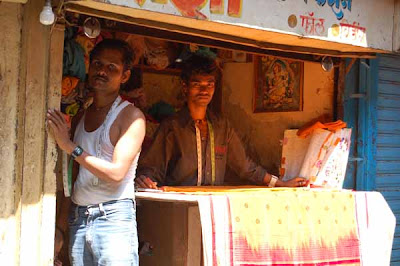
The tailor’s shop is about 7 feet wide and 4 feet deep.
The demand for retail space in Dharavi is enormous. A shop of only 4 feet deep, or even less, is therefore already worth exploiting. Vending often begins on a cloth on the street, backed by a blind wall in an alley. A little stall is a step forward. A built shop is the logical follow up.

The tailor’s shop on the left, beginning street vendors on the right.

On top of the shop a floor was created for a room. By extending this floor over the street, more room is created inside. The extra floor doubles as a weather shade, protecting the shop against sun and rain. The shop’s counter can be moved outside, leaving more space inside the shop. Business is perfectly tuned with the spatial dimensions of the shop. No stock is kept here, production is located elsewhere.


In the shop, client’s orders are taken and delivered. All agreements regarding the design are collected in the order book. All sizes of the customers can be found here. Samples mark the chosen fabric. When a customer arrives to collect the order, a staff member walks to the studio to fetch the gown.


Production takes place in the studio on top of the shop. Thus the distance between production and retail is kept very short and efficient. The alley is in close proximity to one of the busiest streets in Dharavi, which is good for patronage.

The shop and the studio are built to a blind wall. That wall is part of a bigger house dating from times this was still a normal fishermen’s village. This story of building to and building upon is typical for the architecture of informal development and slum areas. The forces of society are clearly visible. The owner of the house was willing (or had to be) to allow trading next to his property. The width of the original alley allowed for a stall of only 4 feet. The stall was improved to a built shop. On top of that came a studio, jutting out over the street. Thus the entrepreneur found shelter for his business.




Amazing when find small entrepreneurs on slum areas.
ReplyDeletethanks for this
ReplyDeleteGet appointments from clients in your area by register your tailor services on Aainaa App
ReplyDelete